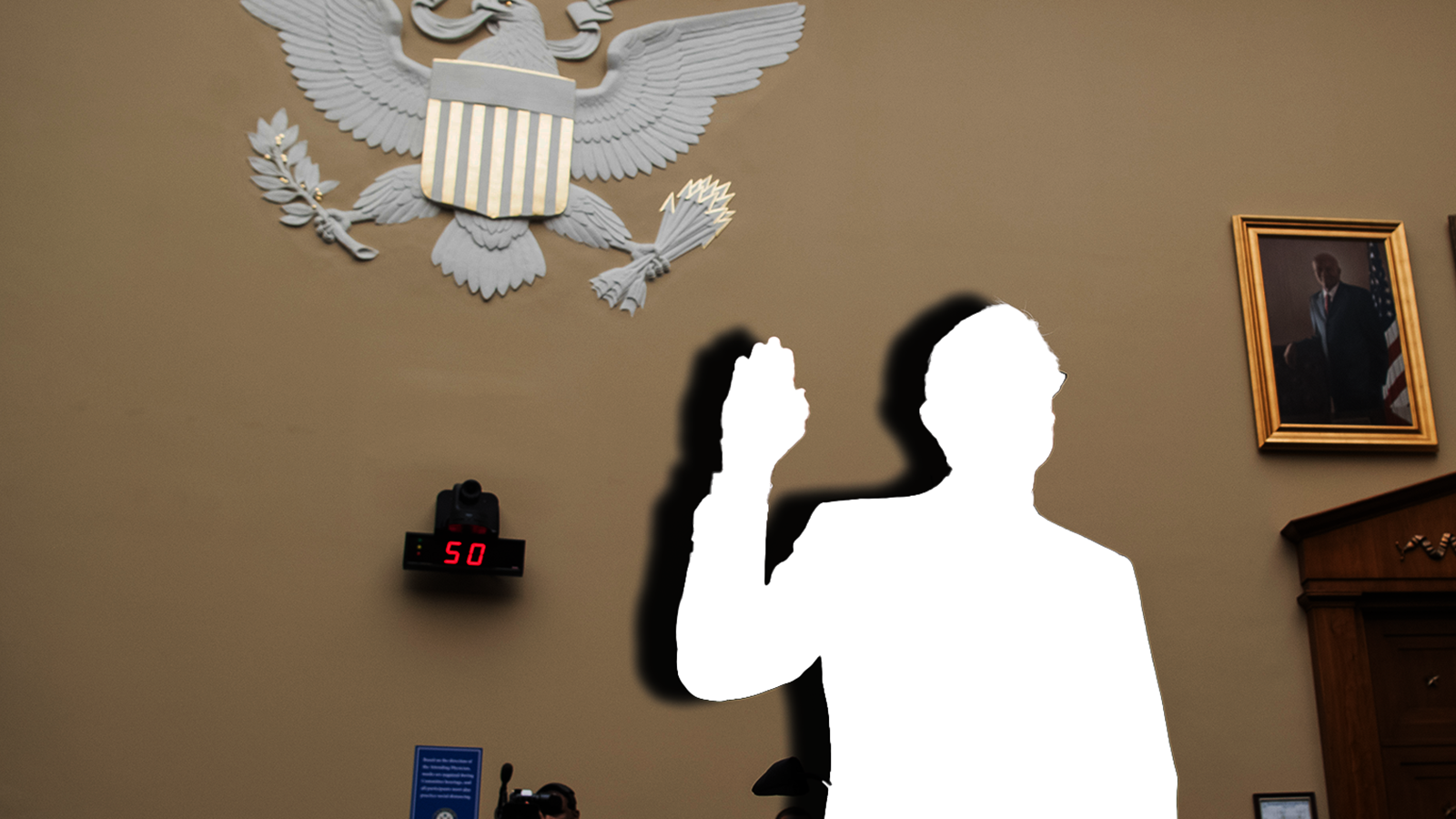
Numerous Defense Department positions have yet to be filled. (Graphic by Breaking Defense. Original photo by Saul Loeb-Pool/Getty Images)
One year into Joe Biden’s presidency and a striking number of vacancies remain in key Pentagon posts, as some nominees face partisan obstacles and others simply haven’t been named. In a new analysis based on new figures, AEI’s Bill Greenwalt provides a damning status report and warns that US security could be at risk.
Following the nominations process for political appointees at the Department of Defense has been similar to watching the fine intricacies of paint drying, with scarcely more than a couple dozen confirmed over the course of the last 12 months.
Then in a movement that might startle a sleeping sloth, Senate Majority Leader Schumer on January 20 filed cloture petitions on four Department of Defense nominations. For a brief moment in time, it looked like perhaps the long delays in filling national security positions in the Biden administration may at last be coming to an end.
Alas, even with three names coming out of the Senate Armed Services Committee late Tuesday, this optimism is probably misplaced.
The first full Senate votes this week were not for a DoD nominee but for federal judges, and it is likely more judges will jump the queue. Still at least for these four defense nominees, including Andrew Hunter, the Air Force acquisition nominee who has lingered in the Senate for almost seven months, things look a bit more promising. As for the rest of DoD appointments, I wouldn’t hold your breath.
The delays, while not without frustrating precedent, should have been anticipated by a president who spent his career on the Hill, and should be prioritized by a senate majority leader – and politically inclined lesser lawmakers – so that politics and bureaucracy don’t leave US security at risk, as they have with devastating consequences in the past.
Senate floor time is a scarce commodity in an election year and even with bipartisan support nominations still eat up a lot of time. Competing priorities include last year’s yet-to-be-completed appropriations process facing a looming February 18 shutdown deadline and a possible resurrected budget reconciliation package. Justice Stephen Breyer’s retirement announcement is further cause for gloom as it will likely suck all of the oxygen out of the Senate chamber. As the Senate often finds it hard to walk and chew gum at the same time, the Pentagon and other national security agencies should continue to plan to operate with a skeleton crew.
At one point there was agreement that this all mattered — that a less than full complement of political appointees had harmful consequences for national security. Being shorthanded puts a strain on the decision-making process and presents a danger that important things can be missed, especially in a crisis. One of the key observations and concerns of the 9/11 Commission was that the Bush administration lacked its full national security team at the time of the attacks and many of those in place had barely been on the job for a few weeks.
If only Secretary of Defense Lloyd Austin and Secretary of State Antony Blinken had it so good. The Partnership for Public Service in its latest snapshot of political appointees found that a year into the Biden Administration only 55% of top national security positions were filled — a slightly lower rate than 57% on September 11, 2001. A careful read of the Partnership’s report finds that while things were bad in the Bush and Obama days, they have only gotten worse in the Trump and Biden administrations.
For those without a scorecard, here is the current status of defense nominations, according to a Hill staffer. There are a total of 61 civilian DOD positions that require Senate confirmation. Twenty-eight have been confirmed and are at their desks, or less than half of the required total. Of the remaining 33, there are 11 positions that have no nominee.
Three of those 11 are covered by what are known as intents to nominate, which means the executive branch still doesn’t have its act together to finish the paperwork to actually send up a nomination to the Senate. The most significant of these intended nominations is the Undersecretary for Acquisition and Sustainment, William LaPlante, announced two months ago and yet the Senate has not received an official nomination.
So there are 22 remaining DoD positions somewhere in the pipeline in the Senate. The Senate Armed Services Committee (SASC) continues to operate as efficiently as it always has. Nominations sent to SASC are usually reported to the Senate floor within a six-to-eight-week window. Perhaps sensing some urgency and exasperation, the three nominees announced Tuesday – all at the assistant secretary level – were “immediately reported to the floor,” SASC said.
There are still currently eight nominees awaiting a committee hearing: four were received in late 2021 and another four in January. Of these only the Air Force general counsel position has been in committee longer than two months and that is likely an indication of some unresolved issue. After Tuesday’s committee votes, one remaining nominee, Brenda Fulton, who attracted some controversy in her October hearing is still waiting for a committee vote.
Altogether there are now 13 DoD nominees awaiting a floor vote and here the process has stagnated. This is not surprising if one looks to past precedent. Historically, there has been a honeymoon period for nominations.
Senior leaders like the secretary of defense and state are usually confirmed as close to the president’s inauguration as possible. Deputies and undersecretaries are nominated shortly thereafter and usually confirmed by early spring, with lesser officials working their way through the process by the summer of the first year of an administration.
By late summer the honeymoon period is over and things get harder as Senators begin putting serious holds (objecting to floor consideration) on lessor nominees to extract some kind of policy or legislative concession.
All of this happens like clockwork and it is not like the president nor his staff didn’t spend most of their careers on Capitol Hill and somehow missed this. The lesson is to have your act together and fill the nominations pipeline early. The Biden administration for whatever reasons did not do that. Some will push back that neither did the Trump administration, but to equate oneself as being as equally inept as its predecessor is probably not saying much.
If one is too slow in choosing candidates upfront then a strategy is needed to overcome later expected floor delays. The senate majority leader has the power to schedule and prioritize floor time and streamline the process for nominees that he and the administration care about. Most defense nominees have bipartisan support and once a vote is scheduled candidates are confirmed easily. It just takes time. As holds begin to be put on nominees, either deals need to be struck or cloture has to be filed to force debate on nominations. This did not happen over the last year as other matters dominated the Senate calendar.
Thus, the signal sent is that the administration or the majority leader have not cared enough about staffing the national security agencies to force floor consideration. Senator Josh Hawley’s quixotic and counterproductive holds on these nominations have served as a convenient excuse not to put any real effort into confirming national security nominations.
Still, the reality is these holds can easily be overcome if there was a willingness by Senate leadership to force what will likely be overwhelmingly bipartisan positive votes. That speaks volumes as far as priorities go.
Bill Greenwalt, long the top Republican acquisition policy expert on the SASC, rose to become deputy defense undersecretary for industrial policy. A member of the Breaking Defense Board of Contributors, he’s now a fellow at the American Enterprise Institute.
Pass a preemptive CR, deal with inflation and watch the debt limit: 3 tasks for Congress
John Ferrari and Elaine McCusker of AEI argue in this op-ed that Congress needs to act quickly to ensure American national security before getting bogged down in election season.


























